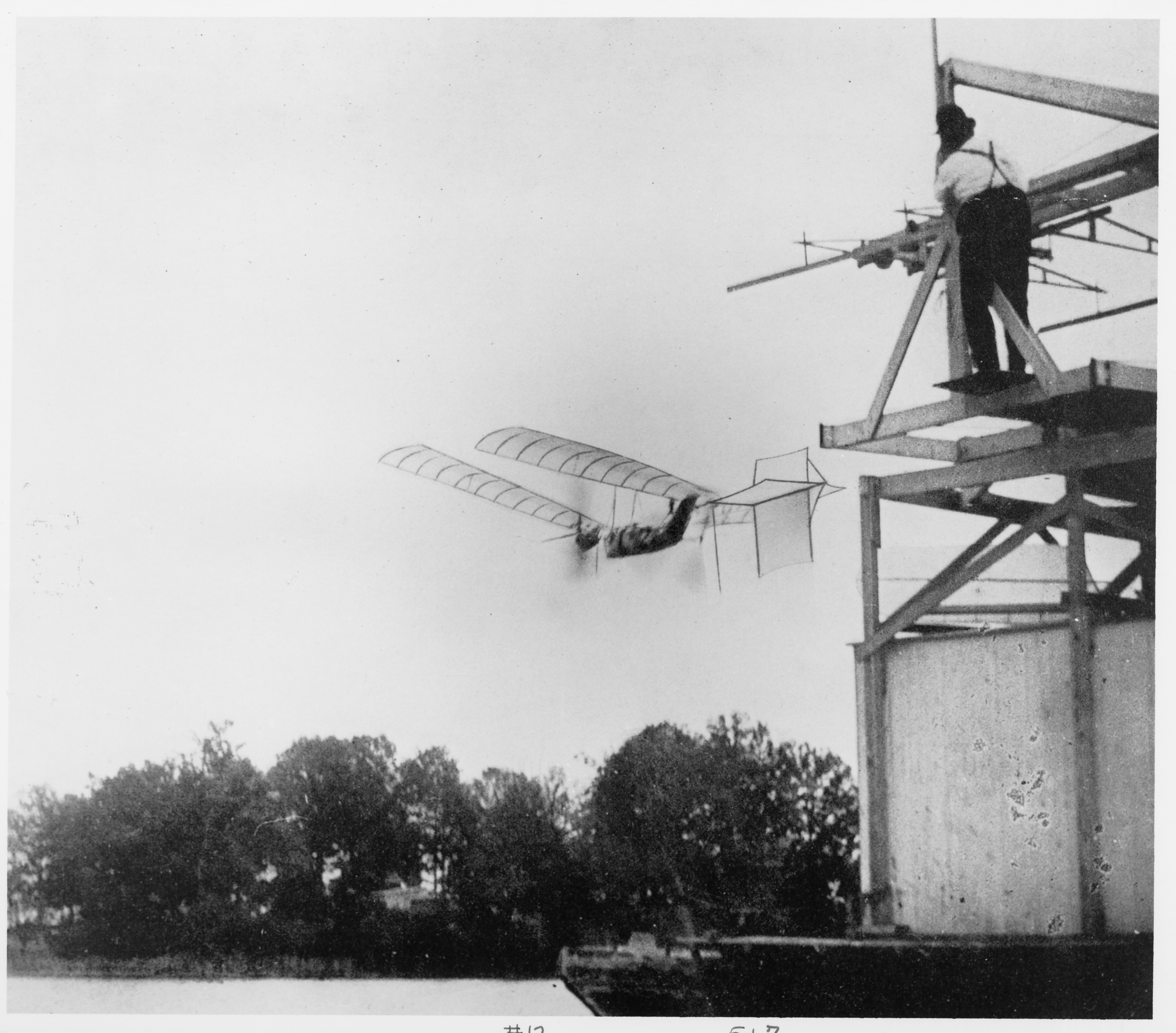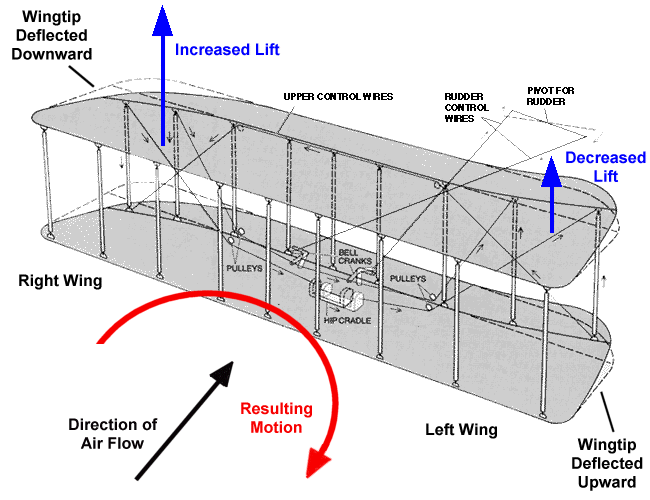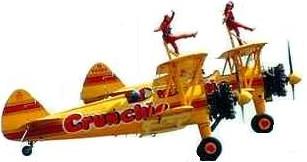Ideas: impact of society on
technology
Airplanes took longer to be practically useful than the automobile, but they were an important symbol of modernity from soon after the Wright Brothers first flight. (Symbol--they had meaning to people beyond their practical usefulness)
Flight had a long prehistory before the Wright Brothers, but inventors who don't successfully market a product don't usually get credit
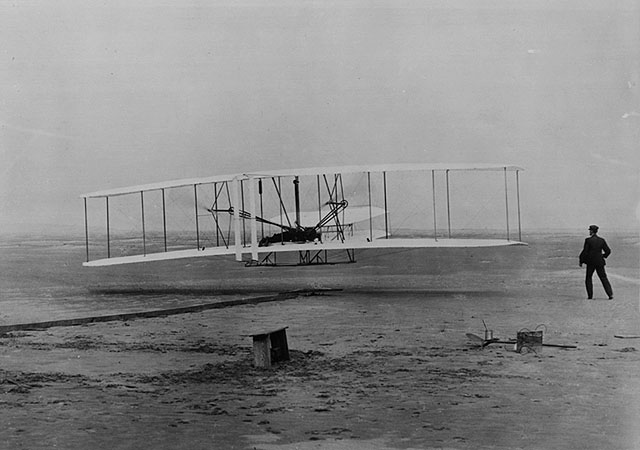
Wright Brothers flight, National Air and Space Museum
Flight was initially used more for entertainment than for practical purposes:
In the era of amateur experiments and barnstorming,
flight became a symbol of freedom
- the dream of flight (is that found in all cultures?)
- the role of science in the invention of the airplane
- amateurs vs. professionals
- what point is defined as the invention (who gets credit)
- what is the purpose of an invention (killer app)
- automobile and airplane invented in parallel
- the airplane as a symbol of freedom and the modern
era
- the dream of an
airplane in every garage
- impact of the airplane on warfare
Prof.
Lienhard on airplanes (3:40) about technological
change
These ideas/questions are conceptual tools
that can be generalized and applied to other cases
Airplanes took longer to be practically useful than the automobile, but they were an important symbol of modernity from soon after the Wright Brothers first flight. (Symbol--they had meaning to people beyond their practical usefulness)
Flight had a long prehistory before the Wright Brothers, but inventors who don't successfully market a product don't usually get credit
- Flight had been a dream for a long time
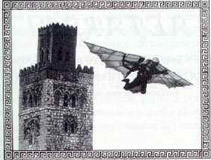
- the legend of Icarus is best know, but occurs in other cultures
- in the Arab world Ibn Firnas launched himself from a tower in a glider (glided down from the tower) in 875 AD and lived to tell the tale
- a monk named Eilmer in England made a similar flight just after 1000 AD
- should gliders (that soar like a bird) count?
- 0.,
records
- early designs for airplanes were usually by direct analogy to birds and therefore with flapping wings (Leonardo).
- Montgolfier brothers used both hot air and hydrogen
- Balloons came into use in the late 18th century and saw significant use in the Civil War and for sport, so there was some familiarity with the atmosphere as an environment.
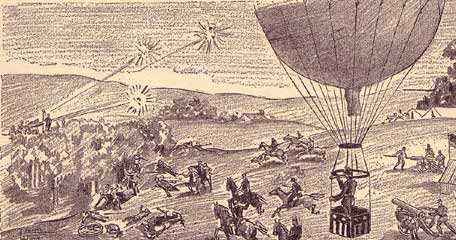
- Sir George Cayley laid out much of the necessary theory for flight in the early 1800s
- the Reverend Burrell Cannon felt called by God in 1900 to build an Ezekiel wheel flying machine
- Frederick Marriott built a steam powered dirigible in 1869
- his nephew John Montgomery made some key inventions in wing shape for gliders in 1883
- In France starting in 1871 Alphonse
Penaud designed rubber band powered model airplanes
using propellers instead of flapping wings
- Octave Chanute experimented with gliders and promoted flight
- wings with lift had been solved for
gliders
- still needed: a successful engine
- how to turn without just slipping sideways
- By the end of the 1800s gliders had been flown successfully up to 250 meters and a number of people were working on powered gliders.
- The Smithsonian Institution's head, Samuel Pierpont Langley, had a government grant to build a heavier-than-air craft. His approach was to "urge a system of rigid planes through the air at great velocity"--in other words like running a knife through butter. He visualized air as a series of identical elastic cubes.
- He successfully flew an unpiloted engine-driven plane before the Wright brothers but his manned version failed to fly and had fundamental problems with control. He owned the Washington establishment--nobody paid any attention to the Wright Brothers.
- the Wright brothers emphasized the fluid nature of air, and sought a plane that was flexible and adjustable, not rigid.
- Now mind you, they were not scientists, but they were bicycle-makers and racers who read the professional literature, studied the problems of aviation with great care and corresponded with other aeronautical researchers such as Octave Chanute. The Wright brothers even built their own wind tunnel--6 feet long and 16 inches square--to study the relationship of various wing shapes and lift and also propellers.

- Some of the other researchers were
professional engineers and scientists, but the Wrights
could do just as good empirical
research
- they used existing scientific knowledge, but this wasn't good enough to actually predict flight characteristics
- they were lucky in the analogies they picked when
there wasn't a clear scientific answer
- they used the scientific method
- they didn't publish scientific
results, they were just trying to solve problems
- they developed a system to turn the plane with a rudder linked to a system to warping the entire wing so that the plane would bank in flight, tested it extensively in gliders.
- They built their own gasoline
engine, because they could not find a suitable one
on the market, and a much more efficient propeller.
They
successfully
flew
a
powered
airplane
Dec. 17, 1903 (for more on the Wright Brothers and
their process of invention--and lots of pictures and
quick-time movies--see To Fly is
Everything and to listen to a story about their
forgotten sister go to: The
forgotten Wright and click listen)

Wright Brothers flight, National Air and Space Museum
- The Wright family gave the plane to
the Smithsonian and "stuck one clause into that
contract that said if the Smithsonian ever says
anybody flew before the Wright brothers, we have the
right to take the airplane back. That clause is in
fact still in the contract," Crouch says. (source)
Flight was initially used more for entertainment than for practical purposes:
- new technologies don't have a lot of rules yet and so often provide a way in for people who are discriminated against, such as women and African-Americans
- women were involved in flight both as rich amateurs and in effect as a freak show--people would pay to see a woman do something they were bored with seeing men do
- airplane builders came to support women pilots for the publicity, with its particular implication that aviation was safe.
- Airplanes were a symbol of freedom to travel
anywhere you wanted
- Harriet Quimby was particularly talented at promoting herself and aviation at the same time
- Bessie Coleman became a figure in the Harlem Renaissance and wanted to set up her own flying school for African-Americans
Freedom:
- getting away from the rules and prejudices of society
- control of your own body
- freedom to go where you want when you
want
Flight inspired much
good literature and became a symbol not just of
freedom but of transcendence, speed, and intensity
Transition
Ch. 11
The popular view of the airplane was based on the idea that danger was fun--people for some years did not take flying seriously
Behind that:
the Wright brothers had a terrible time interesting anyone in their success--the U.S. military did not purchase its first plane until 1909
How did aviation make the transition from entertainment to transportation? With a lot of government help, both subsidies like air mail service and for research
there was a need for research also, or at least coordination, and it almost instantly outgrew the resources of amateurs like the Wright brothers or even the small firms that were building aircraft.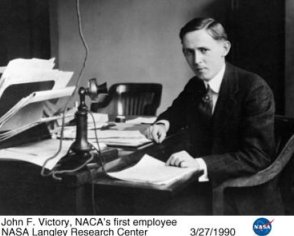
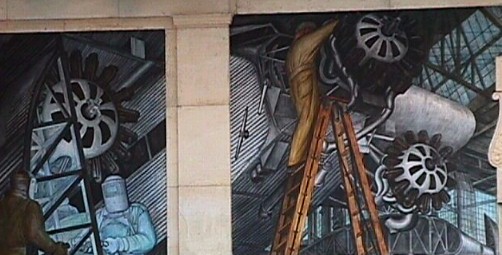
detail from Diego Rivera mural at Detroit Institute of Art
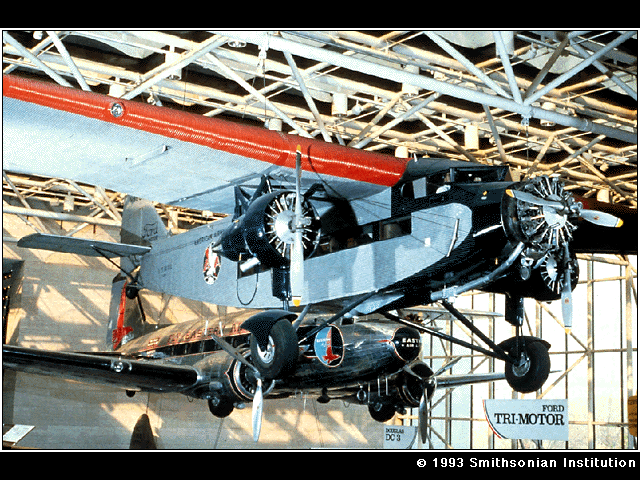
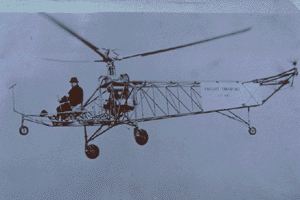
Sikorsky's first helicopter
Transition
- aviation for recreation and entertainment had room for women and African Americans
- then in WWI aviation becomes of military importance, military designs airplanes and trains pilots
- airplanes become symbols of power rather than symbols of freedom
Ch. 11
The popular view of the airplane was based on the idea that danger was fun--people for some years did not take flying seriously
Behind that:
the Wright brothers had a terrible time interesting anyone in their success--the U.S. military did not purchase its first plane until 1909
- Europeans were more interested, and during
World War I learned to use aircraft for
reconnaissance, bombing, and fighting
- when the U.S. entered World War I
in 1917, we lagged far behind in military aircraft

- In the year before the U.S. declared war the U.S. aviation industry produced 411 planes, though a large number of airplane engines were shipped to Europe by one company partnership that had designed a good lightweight engine and techniques for mass-producing it (the Liberty Engine, Packard and Hall-Scott).
- by the end of the war in 1919 the army had 5,500 planes, though most of the fighters were purchased in Europe. The U.S. industry did successfully produce trainers, and many planes were in production when the war ended
French Spad WWI
fighter--National Air and Space Museum
How did aviation make the transition from entertainment to transportation? With a lot of government help, both subsidies like air mail service and for research
there was a need for research also, or at least coordination, and it almost instantly outgrew the resources of amateurs like the Wright brothers or even the small firms that were building aircraft.
- The National Advisory Committee on Aeronautics was one of a number of organizations created as a result of lobbying by scientists and engineers for a new government role in research and development in World War I.
- President Wilson signed the naval appropriations bill that created the National Advisory Committee on Aeronautics in March 1915. The scientists, engineers and enthusiasts who had lobbied for the bill for more than four years wanted government funding of aeronautical research to allow the United States to catch up with rapid developments in Europe. But the legislation did not pass until the outbreak of war provided an additional push, and the bill did nothing more than create an advisory committee and provide it with a small appropriation.

- The NACA then set out to invent
its own role. In its first few years the new
Committee played a significant role in the wartime
coordination of industry and used some of its
small budget to sponsor research at private
institutions, but its leaders made the building of
a new laboratory their highest priority. The
laboratory at Langley
Field, in Virginia, established the NACA as
a federal research agency despite its title as an
advisory com
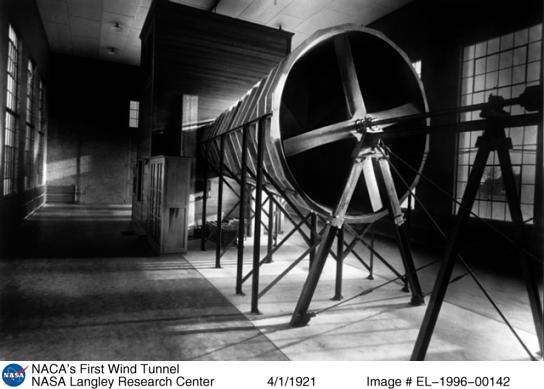 mittee. After the war ended,
debates over the role of the federal government in
supporting and regulating aviation created
considerable uncertainly about the future of the
NACA, but the final result strengthened the
Committee's emphasis on research because other
aviation-related functions--regulation and the
sponsorship of infrastructure--were assigned to
the Department of Commerce. The federal
government also helped the aviation industry by
funding air
mail service.
mittee. After the war ended,
debates over the role of the federal government in
supporting and regulating aviation created
considerable uncertainly about the future of the
NACA, but the final result strengthened the
Committee's emphasis on research because other
aviation-related functions--regulation and the
sponsorship of infrastructure--were assigned to
the Department of Commerce. The federal
government also helped the aviation industry by
funding air
mail service.
- At the Langley Memorial Laboratory, dedicated in June 1920, NACA scientists and engineers set out to invent a role for the federal government in peacetime aviation research. The laboratory provided fairly up-to-date facilities: a wind tunnel, an engine-dynamometer laboratory, and a general research laboratory building.
- The laboratory developed a focus on aeronautical principles both in order to take advantage of its wind tunnel facilities and to avoid competition with the military services (which wanted to maintain control of testing and setting specifications for new aircraft designs for miliary missions) and the National Bureau of Standards and industry (which had facilities for engine research).
- The NACA found a niche not only in its choice of research program but also in how it approached research problems: "The strength of the NACA seems to be that it had the luxury of pursuing incrementally over a long period of time answers to problems that were of great interest to the commercial and military worlds."
- The leaders of the NACA initially thought that the committee had to establish its reputation by scientific (not engineering) achievement, and hired Max Munk from Germany because of his theoretical reputation. Munk made a key discovery, that by compressing the air in a tunnel you could use scale models in wind tunnels to provide results that would correlate with data from a full-sized plane in actual use. This idea was put into use in a 5 foot diameter variable density tunnel in 1923, and then was followed by a 20 foot diameter tunnel for full scale research in 1927. NACA's first wind tunnel
- the NACA used the large tunnel for research on propellers, landing gear, and drag. They discovered that the engine provide as much as 1/3 of the plane's total drag, and invented a way to cover the engine to enhance cooling while reducing drag. During a test a plane that normally averaged 157 mph averaged 177 mph. But this wasn't a theoretical breakthrough--each cowling was custom developed for a particular combination of airplane and engine by wind tunnel experiments.

detail from Diego Rivera mural at Detroit Institute of Art
- The necessity of practical results to justify federal funding and the dominant role of engineers on the NACA main committee gradually reversed that attitude, establishing the relationship between theoretical and practical research as a central tension within the laboratory and the agency as a whole.

- because there were more surplus airplanes than demand, production of new airplanes almost ceased until the government rescued the industry by creating an air mail service
- Aeronautical Engineering began to develop as a field of study: in 1929 1400 students were studying aero-engineering in more than a dozen schools.
- Meanwhile, aircraft design was developing in the 1920s and 1930s as the market finally began to expand again.
- Ford trimotor of 1926--metal structure and cantilevered wing.
Ford Trimotor, National Air
and Space Museum
- People began to predict that soon there would
be
an airplane in every garage
- Aluminum propeller developed in 1925, and variable pitch propellers by the end of the decade.
- The first successful helicopter flew in Germany in 1936; Russian emigre Igor Sikorsky had a U.S. design in tests by 1939 and got a contract from the army in 1940

Sikorsky's first helicopter
